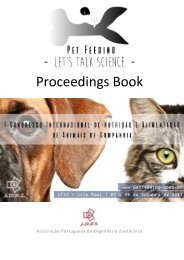Book of Proceedings I PetFeeding
Book of Proceedings I PetFeeding
Book of Proceedings I PetFeeding
You also want an ePaper? Increase the reach of your titles
YUMPU automatically turns print PDFs into web optimized ePapers that Google loves.
51<br />
ages do not always match; 2) there is quite some controversy on where and if nutritional<br />
guidelines should differ between older and younger adult healthy cats (see review Laflamme &.<br />
Gunn-Moore, 2014).<br />
Probably due to their strict carnivore evolutionary nature cats developed an idiosyncratic<br />
metabolism and, with it, a peculiar dietary requirements when compared to many other species.<br />
This include specific amino acids (carnitine, arginine, taurine) and some vitamins (niacin, A,<br />
and D) (read for details Morris, 2002).<br />
Protein<br />
Protein provides energy and is a source <strong>of</strong> nitrogen and essential amino acids. Signs <strong>of</strong> protein<br />
and amino acid deficiencies include lack <strong>of</strong> growth (in animals that are still growing), decrease<br />
in food intake, muscle wasting, hypoalbuminemia, skin and fur alterations, a decrease in<br />
essential plasma amino acid concentrations, among other signs.<br />
There are no known excess amount <strong>of</strong> protein that would cause an adverse effect when fed to<br />
adult healthy cats. Thus, there is no upper limit recommendation in the guidelines <strong>of</strong> NRC<br />
(2006) or FEDIAF (2017) for protein.<br />
Minimum protein and amino acid requirements in adult cats were established using mainly<br />
nitrogen balance studies and these were used by NRC (2006) and FEDIAF (2017) to establish<br />
protein and amino acids recommendations. Laflamme & Hanna (2013) fed adult cats 3 different<br />
dietary protein concentrations for 2 months. Their results showed that minimum protein intake<br />
to maintain a zero nitrogen balance was 2.1 g/kg 0.75, whereas the amount <strong>of</strong> protein to<br />
maintain lean body mass (LBM) was estimated to be 7.8 g/kg0.75. These researchers suggested<br />
that to maintain adequate muscle mass higher amount <strong>of</strong> protein than the recommended by NRC<br />
would be needed.<br />
Arginine is needed in sufficient amounts for the urea cycle. Cats are unable to synthesize<br />
significant quantities <strong>of</strong> ornithine or citrulline within the intestine and both are precursors to<br />
arginine synthesis (Armstrong et al., 2010). Although only reported with experimental diets,<br />
arginine deficiency can have dramatic effects in cats. High protein diets without arginine were<br />
reported to cause hyperammonemia in less than one hour, with severe signs <strong>of</strong> toxicity (i.e.,<br />
vocalization, emesis, ptyalism, hyper activity, hyperesthesia, ataxia, tetanic spasms, extended<br />
limbs with exposed claws, apnea and cyanosis) and to cause death within two to five hours <strong>of</strong><br />
intake (MacDonald et al., 1984).<br />
Taurine is a β-amino sulfonic acid, abundant as a free amino acid in the natural food <strong>of</strong> cats,<br />
such as small rodents, birds and fish. .Many species can use either glycine or taurine to<br />
conjugate bile acids into bile salts before they are secreted into bile. Cats can only conjugate<br />
bile acids with taurine. Three syndromes <strong>of</strong> taurine deficiency in cats have been well<br />
established: 1) feline central retinal degeneration, 2) reproductive failure and impaired fetal<br />
development and 3) feline dilated cardiomyopathy (Armstrong et al., 2010). Hearing loss,<br />
platelet hyperaggregation and impaired immune function have also been demonstrated.



